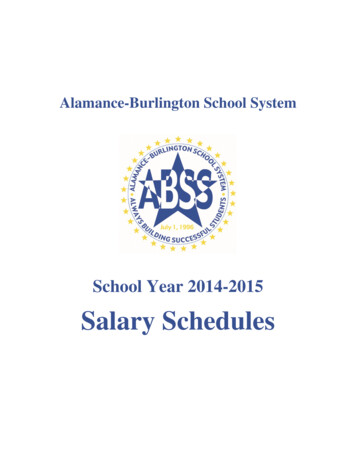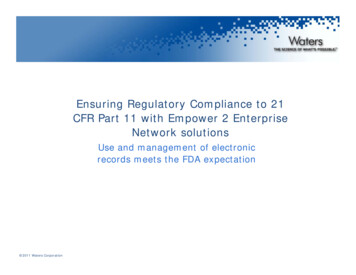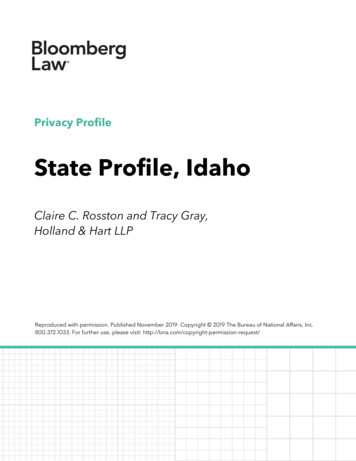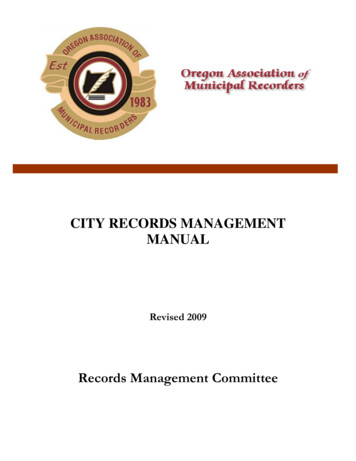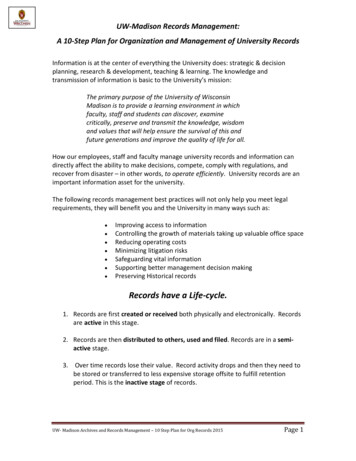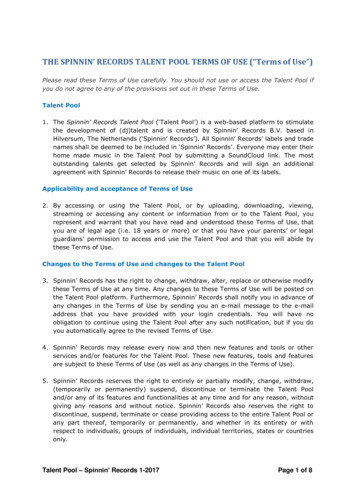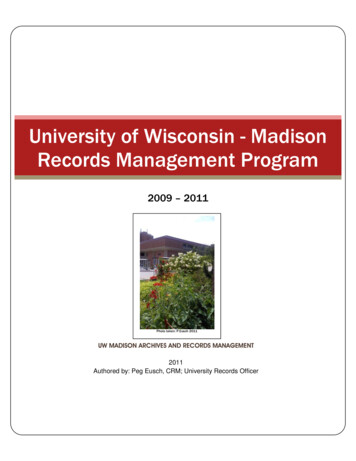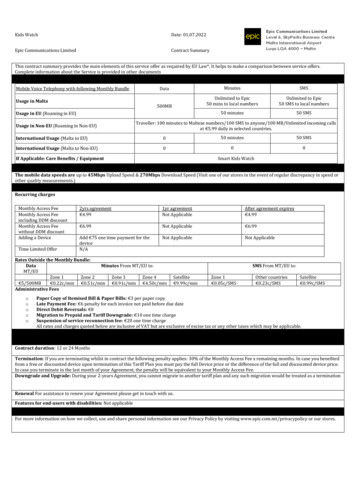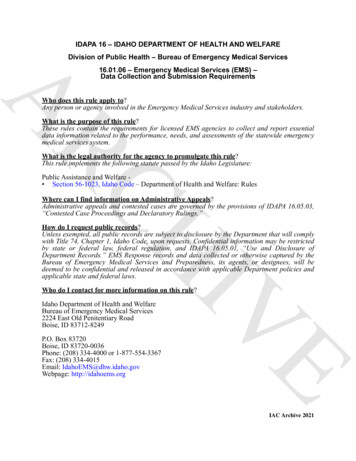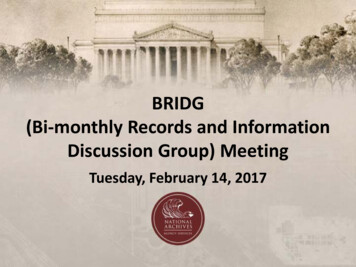
Transcription
BRIDG(Bi-monthly Records and InformationDiscussion Group) MeetingTuesday, February 14, 2017
Ask Questions RemotelyChat via YouTubeOrEmailRM.Communications@nara.gov
Agenda Jay Trainer: Introduction of Alina Semo, Director,Office of Government Services (OGIS), and MarkBradley, Director, Information Security OversightOffice (ISOO) Donald Rosen: Records Management Oversightand Reporting: Annual Reporting Update Kim Gentile: Civilian Personal Records CenterMission and Activities Margaret Hawkins: 2016 Records ManagementCustomer Satisfaction Survey Results
Introduction of New Director’sJay TrainerExecutive for Agency Services
Agency Services’ New Directors Alina Semo, Director, Office ofGovernment Services (OGIS) Mark Bradley, Director, InformationSecurity Oversight Office (ISOO)
Alina SemoDirectorOffice of GovernmentServices (OGIS)
Office of Government Information Services(OGIS)The Federal FOIA Ombudsman
What is OGIS? Created by the 2007 OPENGovernment Act of 2007 We provide dispute resolution servicesto resolve FOIA disputes – as a nonexclusive alternative to litigation We review agency FOIA policies,procedures & compliance
Dispute resolution What’s new? FOIA Improvement Act of 2016 – Signed into law June 30, 2016 Requires agencies to notify requesters of theavailability of OGIS services when (a) agencies take additional time to responseto a request in cases in which “unusualcircumstances” exist(b) agencies provide an initial response to arequest with an adverse determination
OGIS Caseload200018001600140012001000Cases openedCases closed8006004002000FY 2010FY 2011FY 2012FY 2013FY 2014FY 2015FY2016FY 2017 (as of2/2017)
OGIS Cases Opened in FY 2015 and FY 000FY 2015Oct -JunJul - SepFY 2016
OGIS Cases Opened by Fiscal Year (FY) Quarter9008007006005004003002001000Cases OpenedFY 15 Q1FY 15 Q2FY 15 Q3FY 15 Q4FY 16 Q1FY 16 Q2FY 16 Q3FY 16 Q4247264325325328329299787
Compliance What’s new? FOIA Improvement Act of 2016 – Requires OGIS to “identify procedures and methodsfor improving compliance” under the FOIA In FY 2016 – OGIS completed assessments of threeagency FOIA programs: TSA, CBP and USSS We published “still interested” letters report We launched self-assessment program
Compliance – Cont. In FY 2017 OGIS plans to complete assessmentsof agency FOIA programs at Consumer FinancialProtection Bureau (CFPB) and US Postal Service(USPS) Any additional volunteers?
Compliance – Cont. Review of agency FOIA regulations Required updates by FOIA Improvement Act of2016 Amended agency FOIA regulations are required toinclude procedures for engaging in disputeresolution through the FOIA Public Liaison andOGIS.
Proactive Disclosures through RecordsManagement The FOIA Improvement Act of 2016 amendsSection 3102 of the Federal Records Act, 44U.S.C. § 3102 Requires agencies to establish "procedures foridentifying records of general interest or use tothe public that are appropriate for publicdisclosure, and for posting such records in apublicly accessible electronic format."
RMSA FOIA Questions Strong records management program isimportant complement to a successfulFOIA 12 FOIA questions added to this year’sRecords Management Self-Assessment(RMSA) (Questions ## 26-37)
RMSA Results What is OGIS going to do with responses? Review and compile them into meaningfuldata Use RMSA results to understandgovernment-wide trends and target issuesthat merit further OGIS follow-up for theCompliance Team
OGIS Dispute Resolution Training OGIS offers free dispute resolution skillstraining for FOIA professionals Generally: twice a year Agency-specific training: upon request
Sunshine Week 2017
OGIS Staff
OGIS Contact InformationWebsite: www.ogis.archives.govEmail: ogis@nara.govblog: https://foia.blogs.archives.gov/Twitter: @FOIA Ombuds
Mark BradleyDirectorInformation SecurityOversight Office (ISOO)
Information Security Oversight Office Created in 1978 under Executive Order 12065 Oversee the Executive Branch’s system for classifying, safeguarding, anddeclassifying classified information An organization within the National Archives Receive policy guidance from the National Security Advisor Primary responsibilities. E.O. 13526, “Classified National Security Information” E.O. 12829, as amended, “National Industrial Security Program” E.O. 13556, “Controlled Unclassified Information” E.O. 13549, “Classified National Security Information Program forState, Local, Tribal and Private Sector Entities” E.O. 13587, “Structural Reforms To Improve the Security of ClassifiedNetworks and the Responsible Sharing and Safeguarding ofClassified Information”25
ISOO FUNCTIONS Develop, coordinate and issue implementing directives andinstructions Maintain continuous liaison with all agency’s and conducton-site reviews of their program management Report relevant data regarding each agency's securityclassification program Develop and disseminate security education materials forGovernment and industry Recommends policy changes to the President through theAssistant to the President for National Security Affairs26
ISOO Oversight Authority ISOO’s oversight authority comes from the Presidential executiveorder: “Director, ISOO shall have the authority to conduct on-sitereviews of each agency’s program established under this order, andto require of each agency those reports and information and othercooperation that may be necessary.” Onsite review methods include examination of:o Program Managemento Classification Practices and Procedures to include documentreviewso Training programs for employeeso Internal Inspectionso Security violation handlingo Classified Information Systems27
Classification Management Develops security classification policies for classifying,declassifying and safeguarding national securityinformation generated in Government and industry. Interagency Security Classification Appeal Panel (ISCAP) Public Interest Declassification Board (PIDB) Declassification Assessments Annual Report/Cost Report ISOO Notices28
Classification ManagementPublic Interest Declassification Board (PIDB)An advisory committee established by Congress in order topromote the fullest possible public access to a thorough,accurate, and reliable documentary record of significant U.S.national security decisions and activitiesAdvises the President and other executive branch officials on thesystematic, thorough, coordinated, and comprehensiveidentification, collection, review for declassification, and releaseof declassified records and materials that are of archival value,including records and materials of extraordinary public interest.Provides recommendations to the President for the identification,collection, and review for declassification of information ofextraordinary public interest that does not undermine thenational security of the U.S.29
Classification ManagementInformation Security Classification Appeals Panel (ISCAP)Created by President Clinton in E.O. 12958 in 1995The ISCAP provides the public and users of the classification system with aforum for further review of classification decisionsFour functions:Decide on appeals for classification challengesApprove exemptions to declassification at 25, 50, and 75 yearsDecide on mandatory declassification review (MDR) appealsInform senior agency officials and the public of its decisionsWebsite for declassified documents30
Operations & Industrial SecurityEvaluate the effectiveness of the security classification programsestablished by Government and industry to protect informationvital to our national security interests.National Industrial Security Program Policy Advisory Committee(NISPPAC)State, Local, Tribal and Private Sector Policy Advisory Committee(SLTPSPAC)Conduct On-Site Reviews of Executive Branch Agency classifiedinformation programs31
Operations & Industrial SecurityNational Industrial Security Program Policy Advisory CommitteeComprised of both Government and industry representativesIs responsible for recommending changes in industrial security policythrough modifications to Executive Order 12829, its implementingdirectives, and the National Industrial Security Program OperatingManualAdvises the Information Security Oversight Office on all mattersconcerning the policies of the National Industrial Security Program(NISP), including recommended changes to those policies, andserves as a forum to discuss policy issues in dispute.32
Operations & Industrial SecurityState, Local, Tribal and Private Sector Policy Advisory CommitteeComprised of Federal Government and State, Local, Tribal, andPrivate Sector entities involved in the sharing of Classified NationalSecurity Information, the SLTPSPAC recommends policies andprocedures designed to remove undue impediments to informationsharing with those entities responsible for securing the nation’scritical infrastructure and key resources.33
Controlled Unclassified Information: Executive Order 13556 Established CUI Program ISOO serves as the Executive Agent (EA) toimplement the E.O. and oversee department andagency actions to ensure compliance An open and uniform program to manage allunclassified information within the executivebranch that requires safeguarding anddissemination controls as required by law,regulation, and Government-wide policy34
CUI Executive Agent Functions Development and issuance of implementing directives and guidance, asneeded to implement EO 13556. Approval and establishment of initial CUI categories and subcategoriesbased on agency submissions. Creation of a publicly available registry of all approved CUI categoriesand subcategories, and markings of CUI and their definitions, along withapplicable safeguarding, dissemination, and decontrol procedures. Oversight of department and agency actions to include review of agencycompliance plans to monitor progress towards proper implementation ofthe Order and the initial implementing directive. Establish deadlines for phased implementation of the CUI program byagencies. Publish an annual report for the first five years following the date of theorder and biennially thereafter.35
Contact InformationInformation Security Oversight OfficeNational Archives and Records Administration700 Pennsylvania Avenue, N.W., Room 100Washington, DC 20408-0001202 357 5250www.archives.gov/isoowww.archives.gov/cui36
Records Management Oversight andReporting: Annual Reporting UpdateDon RosenDirector, Records Management Oversight andReporting, Office of the Chief Records Officer
Annual Reporting for 2016 Reports are due March 17, 2017 What reports? Senior Agency Official Report Records Management Self Assessment Federal Email Management Report You should already have Template for Senior Agency Official Report Two Qualtrics links (RMSA and Email) CONTACT US TODAY - if you don’t
What happens next? Posting individual reports to NARA’s website Senior Agency Official Reports Federal Email Management Reports 2016 RMSA Annual Report 2016 SAORM Summary Report Federal Email Management Summary Report
https://www.archives.gov/records-mgmtTo findSAORMreportsStart here!To find allreportsStart here!
Web postedSAORM ReportsWill look exactly asreceived
Web postedEmail Reports Will look somethinglike this It is a little differentthan what youreceived when youhit the submitbutton in thesurvey tool We will be sendingyou a pdf of these
spections.htmlNew webpage for the RM Oversight andReporting Team – start here to find linksto Inspection, RMSA, Email and SAORMreports
eporting
ment-0
f-assessment.html
For Assistance rmselfassessment@nara.gov Qualtrics issues RSMA Federal Email Management Report prmd@nara.gov Senior Agency Official Report Senior Agency Official designations Other questions about Senior Agency Officials
Questions? Contact us at: Donald.Rosen@nara.gov 301-837-3426 Cindy.Smolovik@nara.gov 682-465-3021 Evangela.Wimbush-Jeffrey@nara.gov 301-837-0730
CPRC Mission and ActivitiesKim GentileDirector, National Civilian Personnel Records Center
National Personnel Records Center Civilian Personnel Records Program (CPR) is underthe Federal Records Center Program and is part ofthe National Personnel Records Program NPRC is the central repository of personnel-relatedrecords for both the military and civil services ofthe United States Government Our mission: Make Access Happen
Civilian Personnel Records CenterValmeyer, ILMetropolitan St. Louis
Our Facility
Our Facility
Our Facility September 2008 construction completed and moveof records began in October 2008 Additional three bays added in 2009 Total available storage 2.5 million cubic feet Office areas can support 100 staff members
Getting Around Our Big Facility
Civilian Personnel Records Program Holdings Employee Medical Folders are housed at CPR Scheduled temporary records with a 60 year retention Official Personnel Records 1974 forward are housedat CPR Scheduled temporary records with a 65 year retention Official Personnel Records prior to 1974 are housedat NPRC/St. Louis Service prior to 1952 are transferred to the Archives Service 1952 and later are permanent records not yettransferred
Civilian Personnel Records Program Holdings Pay Records (Various Agencies) Military Treatment Records and DependentMedicals Requests are received and worked at the Military PersonnelRecords Center Records are couriered daily for work
OPF/EMF: The CPR Registry
OPF/EMF: The CPR Registry OPF/EMF transfers do not require an SF135 All folders are entered into the CPR Registry housedin ARCIS All work on OPF/EMF is done at the folder/civilianlevel ARCIS CPR Registry includes the owner of therecord and the submitting agency
OPF/EMF Services We Perform Processing incoming paper recordsValidating incoming records to manifestsIdentifying submitting agencyIdentifying owner of the recordKeying folder data into the CPR OPF/EMF RegistryLabeling OPF/EMF with identifying information including registrynumber Shelving in registry number order Records Storage Receive electronic transfer of eOPF for inclusion in theNPRC Instance
OPF/EMF Services We Perform Provide Loan and Transfer of OPF/EMF to FederalAgencies eOPF Agencies submit request through the eOPF system Paper Agencies submit request on SF127/SF184 All folders are sent out tracked (UPS or USPS) Provide responses to requests for information fromseparated civilians, third parties and FOIA Copies, transcripts of service and certified copies for all nonArchival records Paper and eOPF records
Storage
Service Time to Customers Loan and Transfer Folder to Agency Request for record received and searched – 1 day to mailroom Mailroom enters tracking data and provides package to shipper Public Requests Request for copies received, searched and copies made – 10days or less to mailroom Request for information or transcript of service received,searched and created – 10 days or less to mailroom Mailroom posts and hands off package to shipper
Digitization Service Provide digitization for Agency needs Examples of projects completed or ongoing: Official Personnel FoldersDigitize interfiles to eOPFService Treatment RecordsAperture cardsID cards
Stratified Billing Agency stratified billing began in FY11 at OPMdirection Services generated by an Agency result in chargesthrough National billing Storage charges are borne by the Owner of theRecord (OPM, USPS or Non-Title 5 Agency)
Stratified BillingBasic Premise If the work is sent or generated by an agency, it will bebilled to the agency If the work is generated by the civilian employee,authorized by them or is FOIA, it is billed to the ownerof the record Storage is billed to the owner of the record FYI—eOPF charges are charged to the eOPF DataWarehouse Program
Stratified BillingNon-record Owner Typical charges most Agencies will see: Transfers in– OPF/EMF Loans and Transfers (SF127 or SF 184) Refile of returned folders Other charges an Agency may incur: Transcripts of Service (if a restricted Agency is requested) Form completion or pay records
Stratified BillingRecord Owner Similar types of charges as for the non-recordowner Additional charges as the owner of the record: Storage charges will be assessed Charges for separated civilian or publicrequests for record copies or information
Key Reminders Do not send any classified records Send your folders by tracked mail and double wrap Include a manifest for incoming records to allow usto validate all have been received (no SF135 isrequired) Include full Agency name, address and contactname/telephone on all manifests and SF127/SF184
Contact Information OPF/EMF Transfers:Civilian Personnel Records Center1411 Boulder BoulevardValmeyer, IL 62295stlcpr.transfer@nara.gov Loans and Transfers SF127/184:618-935-3014 (Fax) Status Check: stlcpr.reference@nara.gov Kim Gentile, Asst. Director for Civilian Personnel Records, 618-935-3005 orkimberly.gentile@nara.gov
“Thank You for Letting Us Serve You”
Records Management CustomerSatisfaction SurveyMargaret HawkinsDirector, Records Management Operations,Office of the Chief Records Officer
1. What is your position?
2. How long have you worked in recordsmanagement with the Federal Government?
3. Is records management currently yourprimary or secondary responsibility?
4. To the best of your knowledge, has your agencysubmitted a records schedule for approval to NARAin FY 2015 and/or FY 2016?
4 a. I personally have submitted a records schedulefor approval to NARA in FY2015 and/or FY2016.
4 b. Of those who answered yes to 4 a, the time NARA tookto approve the submitted records schedule was satisfactory.
4 c. If you have used the Electronic Records Archives(ERA) to schedule records, how satisfied were youwith the way that ERA functioned?
4 d. My agency has not recently submitted recordsschedules to NARA because: (Please select all that apply.)
4 e. I do receive the monthly Report of Records AppraisalActivity from my NARA Appraisal Archivist.
4 f. Is this report helpful?
5. I have a good working relationship with myagency's NARA appraisal archivist.
5 b. When I contact my agency's NARA appraisalarchivist for assistance, I receive a timely response.
5 c. How satisfied are you with NARA schedulingand appraisal services?
7. Are the communications you receive from NARA’srecords management program clear (e.g., Records Expressblog, RM communications email)?
9. How satisfied are you with the support youreceive from NARA on the Annual Move process?
10. How satisfied are you with NARAcommunications on the Annual Move process?
12. Have you taken any of NARA's recordsmanagement courses in FY 2015 or FY 2016?
12 a. How satisfied are you with NARA's recordsmanagement training courses?
13. Have you viewed any of the training materialsavailable on NARA's records management web site (e.g.,such as briefings, web pages, publications, etc.)?
13a. How satisfied are you with the training materialsavailable on NARA's records management web site?
14. How satisfied are you with NARA's recordsmanagement guidance products (e.g., bulletins, FAQs,and white papers)?
Next Steps Monthly Status Reports: contact me directly ifnot receiving ERA Request for Records Disposition: In March, redesigning business objects New Appraiser Visits: Looking at reinstating visitsby newly assigned appraisers
Next Steps Redesigning the scheduling and appraisal part ofwebsite Big Bucket Study Hiring Freeze 5 Appraiser positions unfilled Immediately began reallocating work acrossteam lines Longer-term impact of hiring freeze anddownsizing unknown
Questions?Margaret HawkinsMargaret.Hawkins@nara.gov301-837-1799
Next BRIDG Meeting:Tuesday, April 11, 2017
Proactive Disclosures through Records Management The FOIA Improvement Act of 2016 a mends Section 3102 of the Federal Records Act, 44 U.S.C. § 3102 Requires agencies to establish "procedures for identifying records of general interest or use to the public that are appropriate for public disclosure, and for posting such records in a
